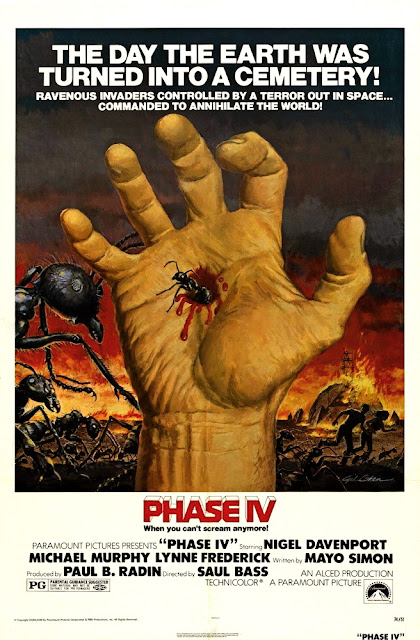While it may be hard to
envision an art movie about super-intelligent ants wreaking havoc on human
victims, Phase IV is just such a
film—a creature feature that balances creepy-crawly horror moments with
elegantly realized compositions and a weird sort of metaphysical wonderment.
Sure, it’s easy to slag the film for being opaque on many levels, since the
(human) characterizations are virtually nonexistent and the ending is a
cerebral freakout in the 2001
tradition, but Phase IV is too
ambitious and interesting to dismiss. Obviously, the most noteworthy thing
about the picture is that it’s the sole directorial effort of Saul Bass, the
celebrated graphic designer who created numerous posters and title sequences
for filmmakers including Alfred Hitchcock and Otto Preminger; accordingly, it’s
fascinating to watch Phase IV for
sequences in which powerfully minimalistic images such as rows of symmetrical
objects evoke Bass’ aesthetic.
Yet it’s unfair to simply categorize Phase IV as a visual exercise, because
on some unknowable level, the movie is about something provocative—a meditation
on the inevitability of man losing supremacy over the Earth, perhaps. Plus, the
picture is quite exciting, speeding through an eventful story in just 84
minutes (the length of the most widely available version), and Bass’ attention
to detail generates a handful of memorable scenes. The story is as bare-bones as one of Bass’ striking posters: Two
scientists establish an outpost in a remote desert to study ants that have inexplicably
joined forces to overrun local livestock. Dr. Ernest Hubbs (Nigel Davenport) is
an obsessed researcher fascinated by the insects’ emotionless collective
endeavors, while his associate, James Lesko (Michael Murphy), is excited by the
challenge of using mathematical analysis to translate the insects’ “language.”
Setting up a fortress-like dome that’s hermetically sealed to avoid contact
with ants, the scientists soon find themselves under siege, so they employ
chemical toxins as a defense measure. Meanwhile, a young woman (Lynne
Frederick) who defied an evacuation order for the surrounding area seeks refuge
with the scientists.
As the movie progresses, the ants grow more resourceful in
their attacks on the scientists, Hubbs becomes more megalomaniacal, and Lesko
grows determined to flee, taking the young woman with him. Phase IV is interesting from start to finish, if only to see what a
truly clinical horror film looks like, and the best sequence is a triumph of
visual storytelling—worker ants carry a crumb-sized sample of a deadly toxin
back to their queen, even though each ant can carry the sample only a short
distance before dying from exposure. Then, after the sample finally reaches the
queen, she ingests the substance and produces a new, genetically engineered
brood—it’s the whole cycle of evolution played out in a handful of minutes.
Sure, one wishes Phase IV had a more
concrete ending, but there’s a lot to be said for leaving viewers with
tantalizing mysteries to ponder.


3 comments:
Bass' original ending was screened in LA...here's a link to a video of that screening and ending...
http://www.youtube.com/watch?v=YCJwUQceLcs
Wow, that's even trippier than the existing version. Thanks for sending the video...
Update: The full version of the film with restored ending was released on disk in 2020.
My view differs from yours. While the workmanlike body of the film functions as a B-movie, it's nothing special. Phase IV slowly comes into its own through the micro-camera sequences and only reaches its pinnacle in the mind-bending finale. The worst thing for the film would be to have a "more concrete ending".
The electronic music (by David Vorhaus and Desmond Briscoe) must be mentioned, as it's essential to the experience.
Post a Comment